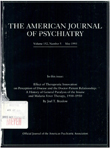Short-term clinical prediction of assaultive behavior: artifacts of research methods
Abstract
OBJECTIVE: The apparent accuracy of predictions of assaultive behavior in psychiatric inpatients varies substantially, depending on the method used to study the prediction. The authors explored the effects of different measures and sampling strategies on short-term clinical predictions of dangerousness. METHOD: The index subjects were patients who were rated by intake clinicians as potentially highly assaultive on the ward (N = 32) and patients who were involuntarily committed on grounds of danger to others (N = 32). The respective comparison groups comprised patients predicted by clinicians not to be assaultive (N = 32) and patients committed for reasons other than danger to others (N = 40). The text of unit meetings and data from chart reviews were used to determine the occurrence and dates of violent acts, seclusions for violent acts or threats, and violent threats. RESULTS: There was a significant difference in the rate of inpatient violence between the subjects rated at admission as potentially assaultive (75.0%) and patients rated as not potentially assaultive (12.5%), but the difference in the rates of violence between the patients who were (56.0%) and were not (42.0%) involuntarily committed as dangerous to others was not significant. Most of the violent acts occurred relatively late in the hospitalization, but seclusions occurred almost exclusively in the initial stages of hospitalization. CONCLUSIONS: The reported accuracy of clinical predictions of assaultive behavior is markedly affected by the choice of sampling strategy, comparison group, outcome measures, and follow-up period. Including seclusion and violent threats in the outcome variable appears to lead to deceptive findings.
Access content
To read the fulltext, please use one of the options below to sign in or purchase access.- Personal login
- Institutional Login
- Sign in via OpenAthens
- Register for access
-
Please login/register if you wish to pair your device and check access availability.
Not a subscriber?
PsychiatryOnline subscription options offer access to the DSM-5 library, books, journals, CME, and patient resources. This all-in-one virtual library provides psychiatrists and mental health professionals with key resources for diagnosis, treatment, research, and professional development.
Need more help? PsychiatryOnline Customer Service may be reached by emailing [email protected] or by calling 800-368-5777 (in the U.S.) or 703-907-7322 (outside the U.S.).



